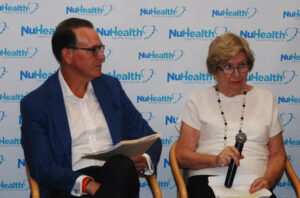By Xiomara Trinidad Perez
Editor’s note: The following is part four of an investigative series examining the state of Long Island’s water supply.
Chemicals that threaten human health, including 1,4-dioxane, flow in Nassau County’s drinking water when it is pumped from the ground, forcing town and other water districts to filter out the chemicals to meet state standards. Meanwhile, New York City’s water is free from these chemicals, which is why one state reports suggests the possibility of Nassau taking at least some water from the city.
Nassau takes its drinking water from aquifers, which are underground water stores located hundreds of feet below the surface. The aquifers have been found, by New York State officials and Long Island-based university researchers, to be contaminated with 1,4 dioxane, a suspected carcinogen, among other contaminants.
Among the other contaminants are also perfluorochemicals (PFAS). According to the federal Centers for Disease Control and Prevention, PFAS are used in the manufacture of fluoropolymer coatings and products that resist heat, oil, stains, grease and water.
According to Thomas Varley, watershed manager at the Stony Brook University’s Center for Clean Water Technology, these chemicals reach the aquifers through the ground.
The state, as well as the Center for Clean Water Technology, have tried to remove the chemicals from the aquifers, but they persist.
According to a 2022 feasibility study by the New York State Department of Health and the Department of Environmental Conservation, New York City reservoirs hold enough water to supply at least part of Nassau’s water needs, in addition to those of the city, even in the worse possible drought conditions. The report states the city could provide 1.2 billion gallons of water per day before its water level dropped below the minimum. Currently, it’s providing 1.1 billion. That would potentially leave up to 100 million gallons for Nassau, which needs 180 million gallons per day.
According to the state, existing water connections between Nassau and Queens counties could be rehabilitated and used to supply 20 million gallons per day. More than that amount would require new infrastructure.
Rehabilitating the old connections could cost $35 million to $53 million, according to the study, while building new infrastructure could run $1.4 billion to $2.2 billion, which could be financed through a combination of existing funding and debt.
According to the study, Nassau would also have to deal with lead in the water. According to the CDC, lead can “be harmful to human health even at low exposure levels,” as it accumulates in the body over time. It is significantly more dangerous to children than adults because of their size.
New York City also fluoridates its water, meaning that the water contains fluoride ions. Nassau does not fluoridate its water. Removing the fluoride would be an additional cost.
According to its website, New York City takes its water from 19 reservoirs and three lakes in a 2,000-square-mile watershed in parts of the Hudson Valley and Catskill Mountains, traveling through the Delaware aqueduct to reach New York City.

According to Gary Ginsberg, director of the State Health Department’s Center for Environmental Health, 1,4-dioxane is “not easy to filter out.” A process called reverse osmosis, which he said cannot be done on a large scale, is needed. Reverse osmosis can only work in individual households. To remove 1,4-dioxane on a mass scale requires the Advanced Oxidation Process (AOP), for which 1,4-dioxane enters a reaction chamber and the chemical is eliminated.
According to Thomas Schneider, director of water quality and laboratory services for the Nassau County Water Authority, AOP eliminates 99 to 100% of 1,4-dioxane.









